Walter Dendy Sadler stands as a significant figure in late Victorian British art, renowned for his charming and often humorous depictions of English life, typically set in the nostalgic eras of the late eighteenth and early nineteenth centuries. A master storyteller with a brush, Sadler captured the nuances of social interactions, domestic moments, and convivial gatherings with a keen eye for detail and characterisation. His work resonated deeply with the public of his time and continues to find appreciation among collectors and enthusiasts of traditional genre painting.
Early Life and Artistic Awakening
Born on May 12, 1854, in the town of Dorking, Surrey, in the south of England, Walter Dendy Sadler came from a background that seemingly encouraged his artistic inclinations. The family later moved to Horsham in West Sussex, where he spent much of his youth. It was clear from an early age that Sadler possessed a natural talent for drawing and observation. By the age of sixteen, he had firmly decided upon a career as a painter, a path that required formal training to hone his innate abilities.
To pursue his ambition, Sadler enrolled at Heatherley's School of Fine Art in London. Heatherley's, known for its less rigid approach compared to the Royal Academy Schools, provided a nurturing environment for aspiring artists. He studied there for two years, immersing himself in the fundamentals of drawing and painting. Seeking further refinement and perhaps a different perspective, Sadler then travelled to Germany. He continued his studies in Düsseldorf under the tutelage of Wilhelm Simmler, a respected German painter. The Düsseldorf school was noted for its emphasis on detailed realism and narrative clarity, elements that would become hallmarks of Sadler's own mature style.
Forging a Career in the London Art World
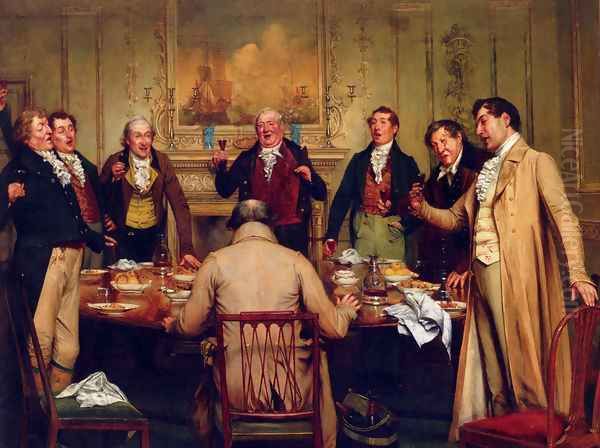
Sadler's professional career began to take shape shortly after his return from Germany. He made his public debut as an exhibitor in 1872, showing his work at the Dudley Gallery in London. This initial exposure was crucial for a young artist seeking recognition. The following year, 1873, marked another significant milestone as he began exhibiting at the prestigious Royal Academy of Arts (RA). Showing work at the RA's annual Summer Exhibition was the primary goal for most British artists, as it offered unparalleled visibility and the potential for critical acclaim and patronage.
Sadler became a regular contributor to the Royal Academy exhibitions, showcasing his paintings there consistently throughout the 1870s, 1880s, and into the 1890s. His appealing subject matter and skillful execution quickly found favour with the exhibition-going public and critics alike. Alongside his participation at the RA, Sadler also became a member of the Royal Society of British Artists (RBA), another important exhibiting society in London. Membership in such organisations further cemented his status within the professional art community and provided additional venues for displaying and selling his work. His reputation as a reliable and engaging painter of genre scenes grew steadily.
The Sadler Style: Nostalgia, Humour, and Detail
Walter Dendy Sadler carved a distinct niche for himself within the broad category of Victorian genre painting. His signature style revolved around meticulously rendered scenes filled with character, narrative, and often, a gentle, observational humour. He rarely depicted the contemporary Victorian world directly; instead, he favoured settings drawn from the late Georgian or Regency periods – roughly the late 1700s to the early 1800s. This historical remove allowed for the depiction of picturesque costumes, interiors, and social customs that offered a nostalgic escape from the rapidly industrialising present.
The humour in Sadler's work is typically character-driven rather than overtly slapstick. He excelled at capturing expressive faces and body language that subtly conveyed personality traits – the self-satisfaction of a country squire, the slyness of a lawyer, the simple piety or worldly enjoyment of monks, the quiet affection between an elderly couple. He observed human nature with an amused but sympathetic eye, often highlighting relatable moments of conviviality, minor vanities, or quiet domesticity. Themes of greed or folly might be touched upon, but usually with a light touch rather than harsh satire.
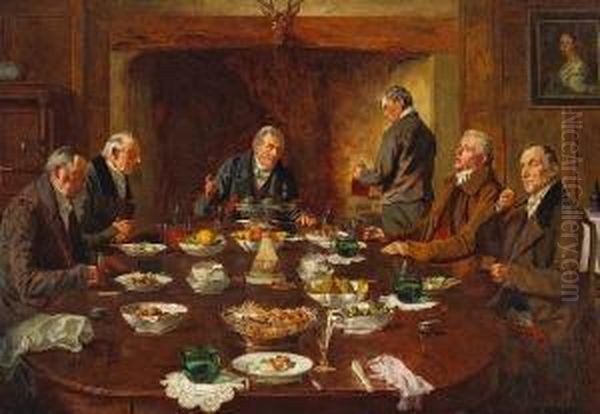
Sadler's settings were varied but consistently rendered with careful attention to detail. He painted cosy domestic interiors, bustling tavern scenes, cluttered lawyers' offices, formal gardens, and even the occasional outdoor sporting scene, such as golf. These environments were populated with accurately depicted furniture, clothing, and accessories appropriate to the chosen period, adding to the historical flavour and visual richness of the paintings. It has been noted that Sadler often reused specific props and even employed the same models in different compositions, suggesting a studio practice focused on carefully constructing these narrative tableaux. His technique involved smooth brushwork and a high degree of finish, typical of academic painting of the era.
Masterpieces and Popular Scenes
Throughout his productive career, Walter Dendy Sadler created numerous works that became highly popular, often disseminated to a wider audience through engravings and prints. Among his most recognised and representative paintings are:
For he's a jolly good fellow (1886): This title strongly suggests a scene of celebration and male camaraderie, likely set in a tavern or a private dining room. It exemplifies Sadler's skill in depicting groups of figures interacting naturally, capturing a moment of shared enjoyment. Such scenes of feasting and drinking were common subjects for the artist.
The Old Song (1895): This work likely portrays a domestic scene, perhaps centred around music-making. The title evokes nostalgia and sentiment, themes frequently explored by Sadler. It might depict family members or friends gathered around a piano or listening to a traditional tune, highlighting the emotional connections fostered by shared cultural experiences.
Monks Dining (1895): Sadler returned frequently to the theme of monastic life, though his depictions often focused on the more worldly comforts enjoyed by monks, particularly their appreciation for good food and wine. These scenes allowed for gentle humour, contrasting the supposed austerity of religious life with evident earthly pleasures. They were immensely popular with the Victorian public.
The End of the Skein: Described as depicting an elderly couple in a warm domestic setting, this painting showcases Sadler's ability to capture quiet intimacy and the enduring bonds of companionship in later life. It represents the more sentimental side of his oeuvre, focusing on tenderness and shared history.
A good bowl of punch: This work, known from auction records, clearly fits within Sadler's favoured themes of sociability and indulgence. Punch was a popular celebratory drink in the historical periods Sadler depicted, and a scene centred around its preparation or enjoyment would offer ample opportunity for character study and narrative detail.
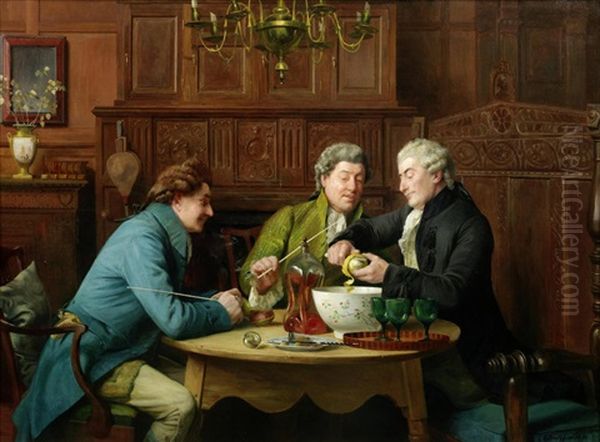
A Breach of Promise (1895): The exact nature of this work is slightly ambiguous based on available information. It could be a painting depicting the social drama and potential legal ramifications of a broken engagement promise, a popular theme in Victorian literature and art. Alternatively, as suggested by some sources, it might refer to a literary or published work by Sadler, though he is primarily known as a painter. If a painting, it would represent a more dramatic or socially pointed subject than his usual convivial scenes.
These titles, along with many others like Thursday (often depicting monks fishing) or Friday (depicting monks enjoying their catch), illustrate the range of narratives Sadler explored within his chosen historical framework.
Sadler and His Contemporaries
Walter Dendy Sadler worked during a vibrant period in British art, and his career intersected with numerous other artists, both stylistically and socially. He is often discussed alongside Frank Moss Bennett (1874-1952), another highly successful painter who specialised in similar historical genre scenes, often depicting taverns, hunts, and moments from history with meticulous detail. Both artists catered to a public taste for narrative and historical reconstruction.
Sadler was also part of a lively social circle of artists. He is known to have invited several prominent illustrators and painters to Chiddingstone in Kent, fostering friendships and professional connections. This group included Phil May (1864-1903), celebrated for his economical and witty line drawings; John Hassall (1868-1948), a prolific poster artist and illustrator; Lance Thackeray (1869-1916), known for his humorous postcards and illustrations; Dudley Hardy (1867-1922), a painter and illustrator associated with poster art and depictions of modern life; and Tom Browne (1870-1910), another popular illustrator and postcard artist, famous for creating the 'Johnnie Walker' striding man logo. Together, Sadler and these friends were instrumental in founding the London Sketch Club, a social hub for artists and illustrators that encouraged camaraderie and informal sketching.
Beyond these direct associates, Sadler's work can be contextualised within the broader landscape of Victorian art. His detailed narrative style relates to the work of painters like William Powell Frith (1819-1909), although Frith tackled much larger, contemporary panoramas like Derby Day or The Railway Station. Sadler's focus on domesticity and sentiment finds echoes in the work of artists like Marcus Stone (1840-1921) and George Dunlop Leslie (1835-1921), though Sadler often incorporated more overt humour.
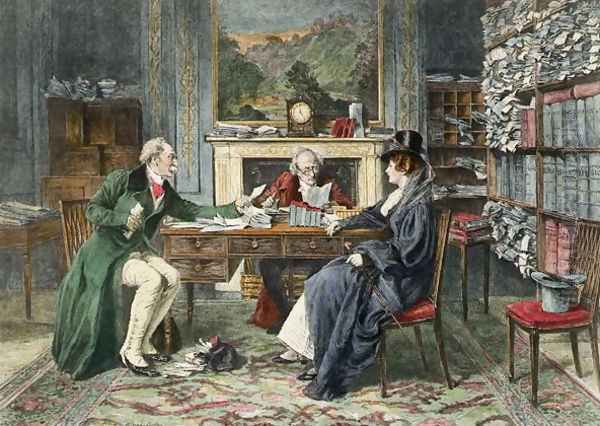
His work stands in contrast to the social realism of painters like Luke Fildes (1843-1927) or Hubert von Herkomer (1849-1914), who often depicted the harsher realities of Victorian life. It also differs significantly from the aesthetic concerns of the later Pre-Raphaelites like John Everett Millais (in his later work) or the burgeoning influence of Impressionism seen in the London work of James Abbott McNeill Whistler (1834-1903) and Walter Sickert (1860-1942). Furthermore, his studio-based, historical reconstructions differ from the plein air realism and focus on rural or coastal working life found in the work of the Newlyn School artists like Stanhope Forbes (1857-1947) and Frank Bramley (1857-1915). Mention should also be made of Briton Rivière (1840-1920), known for his animal paintings often imbued with narrative or anthropomorphic qualities, occupying another popular niche in the Victorian art market. Sadler's specific blend of historical setting, genre subject, and gentle humour secured his unique place within this diverse artistic milieu.
Later Years and Legacy
In 1897, seeking a quieter life perhaps, Walter Dendy Sadler moved from the bustling London art scene to the village of Hemingford Grey in Huntingdonshire (now part of Cambridgeshire). He continued to paint, drawing on the themes and style that had brought him success. He passed away in Hemingford Grey on November 13, 1923, at the age of 69.
Sadler's legacy lies in his contribution to the rich tradition of British genre painting. While perhaps not an innovator in the mould of the Impressionists or Post-Impressionists who were his contemporaries, he was a highly accomplished craftsman who understood his audience. His paintings offered charming, well-told stories that were accessible and enjoyable. The popularity of his work was significantly amplified by the widespread circulation of engravings and other reproductions, making his images familiar fixtures in many middle-class homes.
Today, his work is appreciated for its technical skill, its detailed evocation of a bygone era (albeit an idealised one), and its gentle humour. He remains a key representative of a particular strand of late Victorian taste that favoured narrative clarity, historical settings, and reassuring depictions of social harmony and domestic virtue, often leavened with a touch of wit. His paintings serve as valuable visual documents of the interests and aesthetic preferences of his time.
Collecting Sadler: Market and Institutions
Walter Dendy Sadler's paintings were primarily exhibited at major London venues during his lifetime, most notably the Royal Academy and the Royal Society of British Artists, as well as the Dudley Gallery early in his career. While some sources mention exhibition at the "Royal Society of Australia," this seems highly likely to be a confusion with the Royal Society of British Artists (RBA) or perhaps the Royal Academy (RA), as Sadler's career was firmly centred in Britain. There is no strong evidence of a significant connection to Australian art institutions. It is also important to distinguish Walter Dendy Sadler, the painter, from other individuals with similar names mentioned in disparate sources, such as a landscape architect or a writer on legal matters (like Sir Michael Ernest Sadler, who was an educationalist and art collector, but a different person).
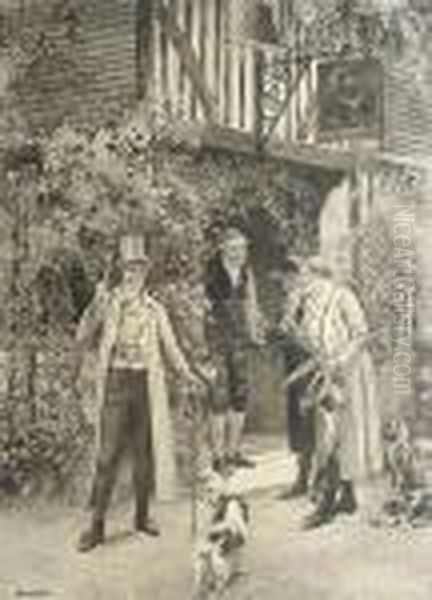
Works by Walter Dendy Sadler continue to appear on the art market, primarily through auction houses in the UK and occasionally internationally. The value of his paintings varies depending on factors common to art market valuations: the size, subject matter, condition, and provenance (history of ownership) of the specific work. Scenes involving monks, taverns, or particularly engaging narratives tend to be popular. As indicated by auction estimates for works like A good bowl of punch (estimated at €4,000-€6,000 in one instance), his paintings command respectable prices, reflecting his established reputation and the enduring appeal of his style and subjects among collectors of traditional British art.
The value is underpinned by his historical standing, the quality of his execution, and the relative scarcity of major works coming to market. Like much art, the market can be subject to trends, but Sadler's position as a significant Victorian genre painter ensures continued interest. His works are held in various public and private collections, though perhaps not as widely represented in major national museums as some of his contemporaries, reflecting the historical fluctuations in taste regarding Victorian genre painting.
Conclusion
Walter Dendy Sadler was more than just a painter; he was a visual storyteller for his generation. His canvases transport viewers to an imagined English past, filled with convivial monks, contented squires, affectionate families, and humorous social encounters. Working with meticulous skill and a fine eye for detail, he created a body of work characterised by its narrative charm, gentle humour, and nostalgic warmth. While operating within the established conventions of Victorian genre painting, he developed a distinctive and highly popular style. Through his long career exhibiting at London's premier institutions and his friendships within the artistic community, Sadler secured a lasting place in the history of British art as a master chronicler of bygone manners and merriment. His paintings continue to delight viewers with their intricate detail, engaging characters, and evocative portrayal of a romanticised past.